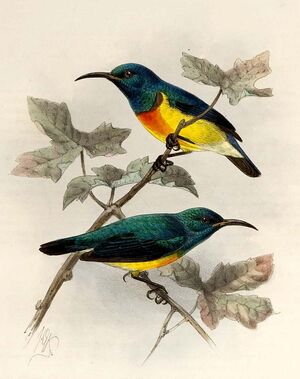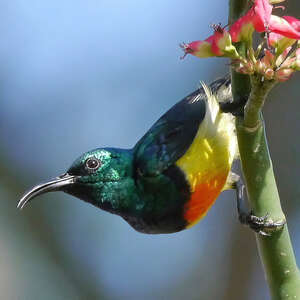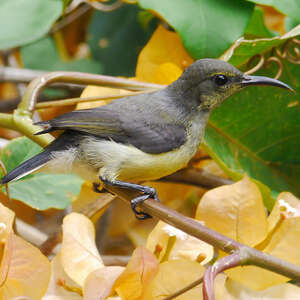Mayotte Sunbird
Cinnyris coquerellii - Souimanga de Mayotte
Identification
The Mayotte Sunbird is one of the endemic and national species of the island. The dimorphism of this little bird is highly marked. The male remains the most beautiful of all Sunbirds in the region. The feathers of the head, neck, chest, back, wings and tail are iridescent and resemble scales. Of metallic green-blue colour, they contrast with the bright yellow feathers of the sides and belly. In the center one can distinguish a small vertical red patch that can be more or less long. A black W-shaped line separates the yellow and red belly from the blue-green chest. The female is much duller and does not possess iridescent colors. Head, back and feathers gray-green-olive. Dirty white throat with thin dark gray stripes and yellow belly. In both sexes the lower belly is white. The legs and the down-curved beak are black. The juvenile looks like the female with a shorter beak. It is called Mwanatse in Shimaorais and Shiberi in Shibushi.
Subspecific information monotypic species
Foreign names
- Souimanga de Mayotte,
- Suimanga de Mayotte,
- nectarínia-de-maiote,
- Mayottenektarvogel,
- Mayotte-i nektármadár,
- Mayottehoningzuiger,
- Nettarinia di Mayotte,
- mayottesolfågel,
- Mayottesolfugl,
- nektárovka svetlobruchá,
- strdimil mayottský,
- Mayottesolfugl,
- mayottenmedestäjä,
- suimanga de l'illa Mayotte,
- nektarnik samotny,
- Нефритовая нектарница,
- マヨットタイヨウチョウ,
- 马约岛花蜜鸟,
- mayottesolfågel,
- 馬約特花蜜鳥,
Habitat
The Mayotte Sunbird prefers open areas and the edges of forests. On Grande Terre it is found everywhere except in the high forest massifs: Monts Choungui and Bénara.
On Petite Terre, it easily comes out into view around Lake Dziani Dzaha as well as on the edge of beaches. It is mainly concentrated in the flowered fields.
Behaviour character trait
The Mayotte Sunbird lives as a couple throughout the year, allowing it to save a significant amount of energy for its nests.
As such, searching for partners and nuptial displays are not the priorities of this bird. The number of individuals seen simultaneously is quite low, but it can form small groups and take advantage of the flocks of birds initiated by the Malagasy cisticolas of Mayotte, Zosterops of Mayotte and Black Bulbul. This way its search for food is more methodical and easier. Again, the savings of energy are significant. As an isolated couple it searches for food in flowering areas, it is in fact the main pollinator of an endemic plant of the island, Aloe mayottensis. It feeds thanks to its long beak and its long tubular tongue which allows it to reach the nectar of the flowers. Often wrongly called a hummingbird (a bird living in America), the Mayotte Sunbird differs from it through its biology which makes it unable to fly in reverse or for a prolonged stationary flight, although it can do so occasionally for a short time.Dietfeeding habits
Reproduction nesting
The breeding season of Mayotte Sunbirds starts in September. Only the female builds the nest while the male stays near and sings.
The nest is shaped like an oval ball, 13 centimeters long and 8 centimeters wide, with a lateral opening. It is made of intertwined dry twigs and is suspended low to the ground. The inside is fully covered with kapok. The female builds a second nest less than one meter from the first, sometimes even a third. Two eggs are laid in the first nest and incubation lasts between 10 and 11 days. For the first clutch, the female is practically the only one who comes to feed at the nest for fourteen days. The male is more involved in the second clutch and even the third. Once out of the nest, the young are fed for a week.Threats - protection
Sources of information
- IOC World Bird List (v15.1), Gill, F and D Donsker (Eds). 2025-12-07.
- Oiseaux des iles de l'océan Indien, Langrand Olivier, ian Sinclair
- Les Oiseaux de Mayotte, Clément Michel, Grissac Philippe, Rolland Robin
- Les oiseaux des espaces naturels remarquables de Mayotte, Rocamora Gérard, Said Soufou, Rolland Robin
- Avibase, Lepage Denis
- Birds of the World, The Cornell Lab of Ornithology
- GEPOMAY,
Other sources of interest
 Specification sheet created on
26/07/2023 by Nathalie Santa Maria
Specification sheet created on
26/07/2023 by Nathalie Santa MariaTranslation by AI Oiseaux.net
© 1996-2025 Oiseaux.net
- Accipitriformes
- Aegotheliformes
- Anseriformes
- Apodiformes
- Apterygiformes
- Bucerotiformes
- Caprimulgiformes
- Cariamiformes
- Casuariiformes
- Charadriiformes
- Ciconiiformes
- Coliiformes
- Columbiformes
- Coraciiformes
- Cuculiformes
- Eurypygiformes
- Falconiformes
- Galliformes
- Gaviiformes
- Gruiformes
- Leptosomiformes
- Mesitornithiformes
- Musophagiformes
- Nyctibiiformes
- Opisthocomiformes
- Otidiformes
- Passeriformes
- Pelecaniformes
- Phaethontiformes
- Phoenicopteriformes
- Piciformes
- Podargiformes
- Podicipediformes
- Procellariiformes
- Psittaciformes
- Pterocliformes
- Rheiformes
- Sphenisciformes
- Steatornithiformes
- Strigiformes
- Struthioniformes
- Suliformes
- Tinamiformes
- Trogoniformes




























